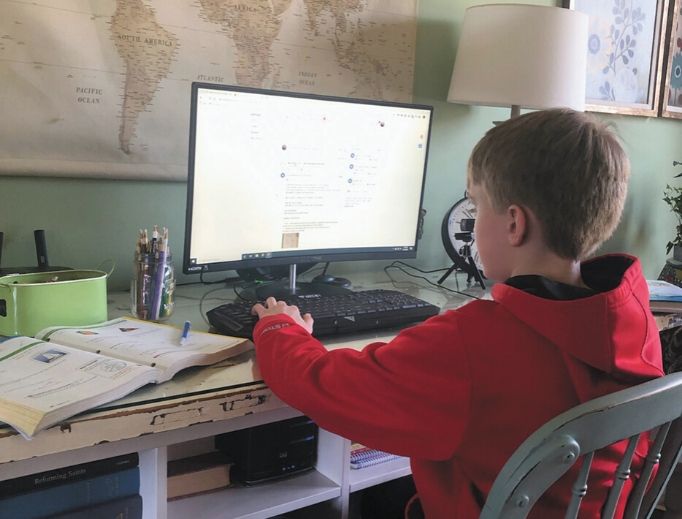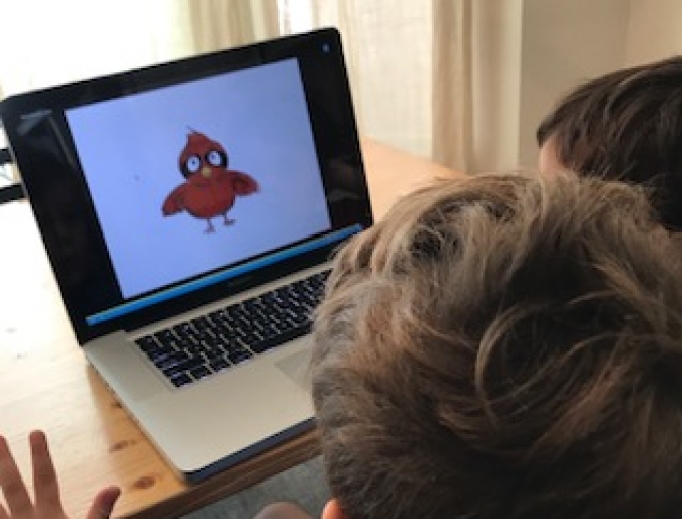In Wake of Coronavirus, Catholic Schools Get Creative With Distance Learning
Shifting from classroom lessons to e-learning has substantial challenges, but educational entities are coping through a variety of innovations.

Parochial schools are exploring new ways of teaching students remotely, while continuing to deliver a distinctively Catholic education, as the coronavirus pandemic sweeps across the country.
While the transition — or, in many cases, a sudden shift — to distance learning represented a dramatic change in life for schools, many also were prepared for it in different ways.
“I think we’ve been very, very blessed that we were in the position that we were in, where it didn’t take a team to ramp up everybody,” said Tim Fletcher, the school vice principal at Our Lady of Mount Carmel Catholic School in Carmel, Indiana. “We literally knew what we were doing before we got into it.”
For the past five years, the school has been holding e-learning days for all students, kindergarten through eighth grade, once in the fall and once in the spring. Originally developed as a way to deal with snow days, the e-school days have also become opportunities for teachers to innovate and hone their skills with the technological tools available to them. The school also has an eye toward leading students for a future where they need to be comfortable using technology for school or work.
In Mandeville, Louisiana, Our Lady of the Lake Roman Catholic School was no stranger to e-learning either. The school had already been using an online platform known as Canvas, which is popular among many educational institutions, for grades 4 to 7. In order to transition to remote learning, the school had asked the company days before they closed if it could relax the platform’s parameters so more users from the lower grades could be added.
Still, the school had to act with a speed rarely seen in the world of curriculum.
“It was exceptionally quick,” said Alice Snee, the school’s curriculum coordinator. “It was jarring.”
Snee said administrators arrived at the school in the morning on March 13 and discussed the possibility that the governor might be ordering schools to close March 16. But the state’s decision did not become official until around 1pm — one hour before school closing time. “It was an exciting hour — that final hour of the day,” Snee said.
At closing time, teachers had prepared books, other materials and a letter with instructions for signing into Canvas for students to take home. By March 18, all 650 students at the school had switched to e-learning.

Students at Our Lady of the Lake School in Mandeville, LA watch a weekly video from the school principal and their Mascot Ollie the Cardinal.
“It went pretty smoothly because it’s something that I had used with my students,” said Snee, who also teaches fourth-grade religion.
Nonetheless, there were still some bumps in the road. In a regular classroom setting, Snee said students who were stumped on a question could raise their hand and get an answer immediately. She gave the example of someone who might have trouble logging into Canvas in the classroom because of a password issue. In the classroom, the issue could be fixed in a matter of seconds. Now, with distance learning, she said it might take a couple of back-and-forth emails to sort out the problem.
A larger issue was planning class lectures. Snee typically lectures in 10-minute bursts, with activities in between. A normal class runs 45 minutes. Now, she has to compress each lesson into 15-minute videos.
“Part of the consideration there is: Can you expect a 10-year-old to sit in front of a computer screen and watch a lecture?” Snee said. After the video ends, students still spend time doing activities on their own.
The condensed lecture time also presents a challenge from the teacher’s perspective. “From a planning perspective, I had to really ask myself, ‘What is the most important thing in this chapter that I really want them to take away?’” Snee said.
Another change: Instead of having all seven subjects in a day, the school realized it would be better to focus on two or three subjects each day. For her, that means religion classes are held remotely twice a week, instead of each day.
So far, Snee says it’s working. “We’ve heard really good things from our parents about our students taking in and actually learning what our teachers are putting out there,” Snee said.
In general, schools seem to use a variety of technological tools and platforms to build digital classrooms.
Our Lady of Mount Carmel’s junior-high school students utilize Google Apps for Education, which provides a whole suite of programs, including a specialized browser suitable for children doing school research. For younger students, teachers connect over a simpler platform known as Edmodo.
But when it comes to live lectures, all grades at Mount Carmel have turned to an increasingly popular platform being used by businesses, local governments and others — the video-conferencing service Zoom.
The school’s e-learning model is still evolving as staff explore new tools. “We’re ramping it up. There was a lot of testing in the last two weeks,” Fletcher said at the very end of March.
“I think we’re doing great, but I try to be realistic, too,” Fletcher added. “The longer we do this we need to be more innovative, more connected, making sure that we’re really preparing these kids to go to the next grade level.”
Parent Mary Collins says her four children at the school were well prepared for e-learning. At first, she says she was concerned what would happen when her children started learning new material for the first time. But so far, there have been few issues.
“The kids have just really plugged in, honestly. I can say I really have only had to help my first grader,” said Collins, who also has children in the eighth, sixth and fourth grades at the school.
Teachers have helped ease the transition, Collins said, with videos asking how they are doing and saying they are praying for them. “It’s just been overall extremely positive for my kids,” Collins said.
Students at the Regina Caeli Academy were also ready for distance learning for a different reason: They already do it three days of the week as home-schoolers, meeting their fellow students in a regular classroom for two days a week as part of a hybrid model with 16 locations across the country. But e-learning was not an option for the Regina Caeli Academy, given its strict commitment to offering a screen-free educational environment. So the school had to figure out how to avoid abandoning that approach while educating at a distance. Its solution: audio conference calls.
Rather than making an exception to the rule, current conditions make holding to the screen-free rule that much more important, according to Kari Beckman, the executive director of the Regina Caeli Academy.
If children at home spend more time online, that increases the chances that they will be exposed to harmful content like pornography, or inappropriate messages that may be harder to block with filtering software. Plus, monitoring of their internet usage becomes that much more of a challenge for parents, Beckman noted. Her opposition to computer, iPads and other similar devices is grounded in her particular philosophy of education. The absence of screens, she said, sharpens students’ powers of imagination.
“It forces the students’ minds to actually build that ‘screen’ in the imagination,” Beckman said. “That then requires the brain to work a little harder and exercise that muscle.”
As more schools have switched to distance learning, the Arrupe Virtual Learning Institute has become a clearinghouse of information and advice for schools just learning the ropes.
Arrupe provides about 30 e-courses on a regular basis to 90 high schools in specialized subjects for which they would normally not be able to offer on their own due to low enrollment — such as statistics or Mandarin Chinese.
Now the institute is sharing its experience with others. In the first week of school closures, the institute hosted sharing sessions on Zoom for teachers to share insights and tips on e-learning and distance learning. The sessions are open to all Catholic schools — not just members.
“We’re just trying to help at this point,” said Jeffrey Hausman, the president of Arrupe.
Arrupe plans to hold two sessions a week, one for teachers and one for administrators. The institute also has launched a special page with information on education and the coronavirus, including a makeshift how-to guide for “Temporarily Moving Schools Online.”
Some of the advice is quite simple but involves things that need to be relearned by teachers in a purely digital environment. “It’s literally things like ‘Provide clear instruction.’ It sounds simplistic, but in the online environment, it’s really, really important,” Hausman said. “When you’re in a classroom, you just give instruction, and kids nod their heads and you’re like, ‘Okay, they get it.’ When you’re online, you don’t have that — the capacity to look out and see that.”
Schools also need to remember that distance learning involves more than just finding a way to get content to students. “More importantly, you really need to think about the other side of learning, particularly in Catholic schools,” Hausman said. “How are you maintaining community? How are you caring for kids?”
At Mount Carmel, Fletcher agrees that schools need to be attentive to the emotional dimensions of the learning process.
“I think the challenge is to keep that face-to-face relationship going. There are kids who will thrive on this, and there will be others that it’s just not their thing. So we have to make sure we’re addressing the whole student body and trying to make sure that they’re connected in special ways to the school and the staff,” Fletcher said.
At Our Lady of the Lake, that means finding ways to extend the school’s sense of community. “We really wanted to maintain the culture of our school throughout this process,” Snee said.
In an effort to do that, homeroom teachers are recording a good-morning video each day with the morning prayers and birthday announcements that would normally have been said in class. Homerooms also have themes — such as superheroes or monkeys. In their videos, teachers try to incorporate something that reminds students of the homeroom theme. The teacher for the jungle-themed classroom places a monkey doll in her videos.
“So it kind of gives them a flavor of what it is like to be in the classroom,” Snee said.
The school principal also sends out a video once a week with a prayer and a message, taking the place of the once-a-week school assemblies. The school has also started making video shorts with its mascot reenacting what students are doing — learning at home, working on the computer and taking breaks to play outside.
“We’re hoping that it reminds the students of what they love about going to Our Lady of the Lake,” said Snee. “We think it’s a very special place, and we wanted to make sure that that stayed in our students’ minds and hearts.”
Stephen Beale writes from
Providence, Rhode Island.
- Keywords:
- catholic education
- coronavirus
- stephen beale

















